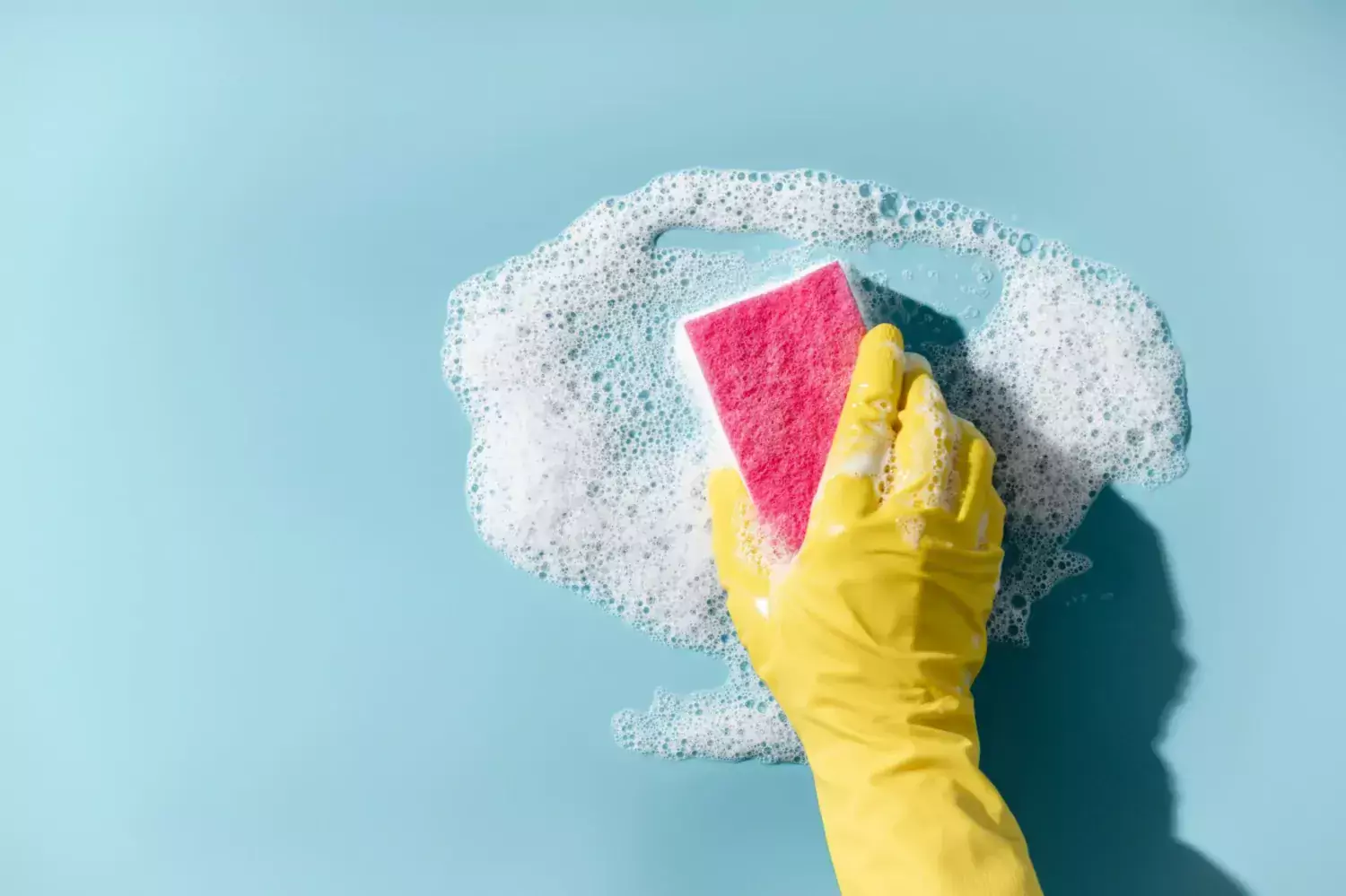Cleaning – not to be swept under the rug

In the healthcare setting, keeping things clean can be vital to prevent the spread of dangerous bacteria. But in a household, what’s best for your health – to live pretty dirty or to be a clean freak? Read our interviews with the researchers who have a pure interest in cleaning.
Text: Annika Lund, in Swedish for the magazine Medicinsk Vetenskap nr 1, 2024
In a well-known scene in Pippi Longstocking, the Swedish children's book character, she is trying to clean her kitchen. Pippi is in a good mood, singing while working, but the horse steps around in a sea of Christmas decorations and the monkey continues to make a mess. Finally, Pippi gives up, leaves the monkey at home and takes the horse out on the town.
Pippi's almost anarchic approach to cleaning has entertained generations. But are the authorities, who are constantly chasing Pippi, right? Is she a danger to herself, would living in Villa Villekulla be hazardous to the health?
Those who seek the answer in the advice of Swedish authorities will have a hard time. There are no Swedish recommendations on how or how often we should clean our homes.

– I am not aware of any strong scientific evidence to rely on. Terms like 'cleaning' and 'clean' are not easy to define and use when we talk about home environments, says Johnny Lorentzen, researcher at the Institute of Environmental Medicine at Karolinska Institutet.
Vermin and allergens
However, there are some general statements about what should not be done in Swedish homes. The Swedish Environmental Code states that homes must maintain a level of cleanliness where "nuisances to human health do not arise" and they must be kept "free from vermin and other pests", as stated on the Public Health Agency of Sweden's website. It also states that the occupant of the dwelling is responsible for ensuring that pests do not spread. But which animals are actually vermin and pests is not specified. According to the Swedish Public Health Agency, they are all animals that can pose a health risk or cause discomfort.
So what does this mean in practical terms, if you want to translate it into how often you need to scrub your bathtub or empty the kitchen waste bin? Have you contributed to the spread of vermin if the silverfish float like mercury in the tile joints while the fruit flies feast on the brown food waste bag?
– I'm not sure how to answer this question. Vermin can enter via various goods, no matter how well you have cleaned. Then, getting rid of them may require extermination. And there is really no evidence that silverfish or fruit flies are harmful to health, except possibly for allergies. But we should still avoid having them in our homes, says Johnny Lorentzen.
Other unwelcome animals have clear health risks attached to them. These include cockroaches and rats, which can spread various infections. Both also release allergens, but so do the welcomed dog and cat. All these allergens accumulate in household dust, which otherwise consists mostly of old skin cells and fibers from textiles. Household dust can also collect allergens from mites, very small arachnids that thrive in our beds. For those with allergies, not cleaning up household dust can be a health risk.
This risk for allergy sufferers is the basis of documents regulating how often schools and kindergartens should be cleaned, according to general advice from the Public Health Agency of Sweden. It also highlights that the dust may contain endocrine disrupting chemicals such as flame retardants from electronics or plasticizers from plastics. In addition, all contact surfaces such as door handles and switches should be kept clean to reduce the risk of infection - when people are in close proximity, bacteria and viruses find it easier to find new hosts.
Overcrowding and mold
But back to home and Johnny Lorentzen's field of expertise. His field is indoor environments in homes from a broader perspective, such as how overcrowding and mold affect health.
When it comes to mold, you could say that the subject is messy to say the least. There are many studies showing that living in houses with signs of mold is associated with an increased risk of asthma. But according to Johnny Lorentzen, it is unclear whether these studies are actually about mold. For example, researchers usually assume that the smell of mold is an indicator of mold.
The problem here is that chemicals that were previously commonly used in building structures, in fact to keep mold away, can after some time be transformed into substances that smell like mold. These substances, chlorophenols, are not good for your health and have been banned in Sweden since 1978. However, they are still present in many building structures from the one million homes program era* and can still cause the smell of mold.
– But these chemical substances evaporate over time. Today, the assessment is that there are no toxic levels left in Swedish houses. However, the smell itself is a problem, as mold smell is perceived as unpleasant and creates anxiety for those living in the house, says Johnny Lorentzen.
He also researches the health effects of overcrowding. A well-documented risk in this context is that infectious agents can spread more easily. This was evident during the pandemic, when people living in close quarters were more severely affected. Can cleaning play a role in this context?
– It is reasonable to think that the spread of infection could be reduced if all spaces in a home were clinically clean. But this is not a realistic idea, he says.
The hygiene hypothesis
But is it always bad to live with a large number of microbes? Can having bacteria and viruses around us be good for our health if they don't make us seriously ill? Could being around certain infectious agents be like sending the immune system to the gym?
An early proponent of this idea is British researcher David P. Strachan, who in 1989 wrote a two page article called Hay fever, hygiene, and household size. It describes how children with many siblings are less likely than other children to develop pollen allergies and eczema. Strachan proposed an explanation: children with many siblings are likely to receive more infections from their older siblings during infancy and this may protect against allergic disease.
This so-called hygiene hypothesis has since been developed. Several large studies have shown that children living in rural environments with animals or in larger families seem to be protected against allergic disease.
Over the decades, attempts to explain this matter have been scattered in different directions, including a focus on gut flora and antibiotic use. But the core of the hygiene hypothesis remains that the immune system needs to be exposed to microbes in order to mature and make the right assessments. Nowadays, autoimmune diseases, such as celiac disease or type 1 diabetes, are also discussed in this context.
But hard evidence has never really been established. The exact mechanisms that describe how allergies or autoimmune diseases occur are not known, so the hygiene hypothesis has neither been proven nor dismissed.

Recently, however, Jonathan Coquet, a researcher at the Department of Microbiology, Tumor and Cell Biology, presented a beautifully designed experiment. He and his colleagues raised genetically identical mice in two different environments. Half were born to laboratory mice and lived as cleanly as laboratory mice usually do, without their mothers from the age of three weeks. The rest were born from captured wild mice. They lived in materials taken from farms, together with siblings for a longer period of time and developed a well-developed intestinal flora.
The result is not at all consistent with the hygiene hypothesis. The mice living in the more natural environment with microbes had strong allergic responses, stronger than the mice in the clean laboratory environment.
– Many research colleagues have expressed surprise. I was open to all outcomes. I have wanted to do this study for several years, but it has been difficult because wild mice are not so welcome in the laboratory environment. Now I would like to continue working with mice in this way. Among other things, I would like to investigate what different factors during pregnancy can mean for the offspring, says Jonathan Coquet.
Cleaning essential in healthcare premises
In other environments, great cleanliness is undoubtedly important. In health care, there is a constant battle against potentially deadly microbes. In this field, there is plenty of knowledge, rules and legislation. Ultimately, the Swedish Health Care Act states that a good hygienic standard is a prerequisite for meeting the requirements of good care.
There are detailed recommendations on how to clean healthcare premises, produced by the Swedish Association for Healthcare Hygiene, which brings together doctors, nurses and other professionals. The document describes which hygiene classes different premises belong to and what this means for cleaning. Premises belonging to hygiene class 0, where only administrative staff and no patients are present, should be cleaned once a week, including cleaning switches and door handles. For hygiene class 3, which includes, for example, the surgical unit and neonatal care, different rules apply to different parts of the rooms: walls should be cleaned daily, suspended ceiling fixtures once a month.

– Our knowledge lies in describing what level of cleanliness different healthcare items should have, i.e. whether something should be clean, disinfected or sterile. But we don't decide how that level of cleanliness is achieved. It is described in procurement documents and is carried out in some cases by cleaning staff and in other cases by healthcare staff, says Birgitta Lytsy, hygiene doctor in Region Stockholm and researcher at the Department of Laboratory Medicine at Karolinska Institutet.
She explains that interest in cleaning in healthcare had a clear dip in the 1960s and 1970s. The turning point came when multi-resistant bacteria began to spread in the 1990s. There are now plenty of studies showing how difficult it is to keep hospital environments clean from the spread of infection. Anyone who takes over a place of care from a patient with multi-resistant bacteria runs an increased risk of contracting the same bacteria themselves. The danger is greatest if the previous patient has been ill with the bacteria. However, the risk also increases in the case of carriage, i.e. if the previous caregiver has only carried the bacteria without becoming ill with them (and perhaps without knowing about them).
The infection is transmitted through all surfaces that patients and healthcare workers come into contact with. Stethoscopes, IV poles, blood pressure cuffs or sink faucets - anything that is touched can help the bacteria spread.
Keep the infections away
Unfortunately, healthcare providers are not able to keep the infections away. According to the National Board of Health and Welfare, about 50 000 hospitalized patients per year get a healthcare associated infection, often in the urinary tract or in surgical wounds. This means that about every third health care injury is a health care associated infection. Every second infection could have been avoided, according to the National Board of Health and Welfare.
There are two ways to transmit infection in hospitals, explains Birgitta Lytsy. In one case, cleaning has failed, leaving infectious agents on, for example, a ventilator or a door handle that comes into contact with the patient. In the second case, staff have transferred bacteria via their hands or clothing.
– It is always one of the two routes of transmission. We need to ask ourselves: how clean do we think the hospital environment with all healthcare equipment should be? If we want to keep it completely sterile, we need to clean so often that it is unrealistic, both from a financial and practical perspective. However, it is realistic for healthcare workers to become more aware of how to work with their hands and clothes. It is possible to raise the level of knowledge there, not least among doctors, whose basic training does not provide sufficient knowledge of hygiene, says Birgitta Lytsy.
She believes that the current recommendations on cleaning and hygiene are reasonable. It is compliance that is the concern. And it is difficult to get an overview - cleaning is a part of healthcare that lacks quality registers or national comparisons. Procurement is designed differently in different regions and carried out by different contractors.
– Cleaning in a hospital requires training on how to clean there. It is not the same as cleaning a school or an office. My impression is that many hospital cleaners unfortunately do not have sufficient training for their job, says Birgitta Lytsy.
*) The Million Programme was a Swedish reform program to address the housing shortage around the 1970s.
